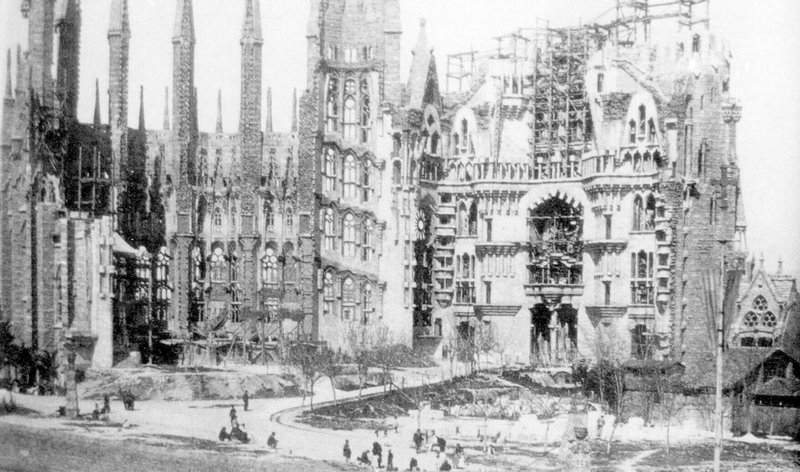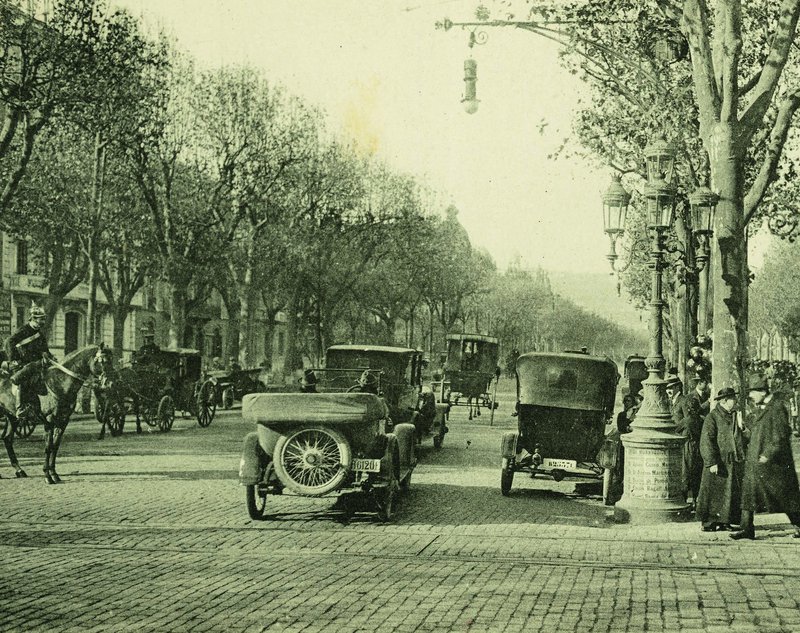In praise of Gaudí
Gaudí's work was already drawing international acclaim from visitors just two years after the architect's death
Women Travellers in Catalan Lands
Another astonishing achievement of Gaudi is the Parque Güell, carried out over the sides and right into the very heart of an extensive hill to the north-west, beyond Gracia, where are also several ornate villas, which have a fine view over these unusual grounds and the city beyond.
The porter's Lodge (where might dwell Hansel and Gretel) is at the right of the park gates; on the left is a curious construction with an immensely tall spire of blue tiles, finishing with a white stone cross. There seemed no means of access even by the one and only door of open ironwork: it had neither handle nor keyhole. Through its interstices and the grilles of a curious window it was just possible to look into a circular room slightly above the level of the road.
If our present civilization were suddenly and entirely wiped out, I can imagine archaeologists of the future pondering and speculating about the purpose of this strange erection. I concluded that it was a tiny chapel for the use of the inhabitants of the gay-colored villas; or, failing that, a shrine to hold the relic of some saint. My airy flights of fancy were brought down to earth by the porter's wife, who assured me that it was intended for a sala de esperar, but as no one ever went in to wait there, the door is now permanently closed.
Immediately in front, some way up the slope of the towering hill, a fountain, the water of which connects with a fairy grotto below, and on the right of that, hollowed out, is a construction of the nature of a shelter and the appearance of a wigwam, all of stone.
A road winds round and up on the right-hand side, with a small pavement following the bend, and curving in and out artificially as well.
In front to the left, a long flight of rugged steps leads to a temple hollowed right into the hill, with sixty-six massive pillars of brown stone, covered to the height of about four feet with mosaic of broken white tiles. These pillars support the roof of the temple, formed by the hill itself, which has been levelled to make an immense open terrace, overlooking Barcelona.
It is entirely surrounded by a white-tiled balustrade and benches attached to it curving in agreement with the edge of the huge open space.
The road approaching this is lined with palm trees planted deeply in the hill, so that little of their trunks is visible, and only the lovely crowns of waving, feathery leaves appear above the path. This really has a beautiful and most original effect, especially as a background to the terrace, and it is duplicated on a higher level of the hill covered with foliage and flowering plants.
Below this sports ground, as it well might be from its size, lies Barcelona, and in a direct line of vision rises the façade of “the Nativity” with cloisters-all that as yet stands materialized of the dream of Gaudi's life, the Cathedral of the Holy Family. It has been called “a symphonic poem of impressionism sculptured in stone”, and was designed by him to be a pictorial representation of the Birth, Passion, Death, and Resurrection of Christ, with four façades representative of thereof-a temple to be built by the nation, in expiation of its sins.
Stone in Cataluña is soft and lends itself to sculpture, especially that brought from Vilafranca, and the details of the statues, palms, flowers, and animals in the façade of the Nativity beggar description; the tree of Jesse in astonishingly beautiful; the architect inspired his workmen.
The crypt too is finished, and I have sat through more than one sermon in Catalan, with the real object presently of feasting my eyes on the ironwork of the sacristy; the branches of roses and leaves in stone to be seen in the door that has been completed for the cloister of Our Lady of the Rosary.
The Temple, quite unfinished as it is, has already cost more than three million pesetas; and unfortunately the birds of the air and the four winds of heaven are continually injuring the fine stone work of the exterior.
It cannot be expected of artistic genius to consider expenditure, and Gaudi was fortunate in possessing wealthy patrons and admirers, whose belief in him was profound and touching. On himself he spent the least possible. His life was simple to the point of severity; practically he kept the rule of a mendicant friar.
HELEN CAMERON GORDON
Helen Cameron Gordon (1867-1949), or Lady Russell, today holds a secondary role in the history of British travel writing because the period during which she wrote –the interwar years– has been canonically monopolised by male travellers like Evelyn Waugh, George Orwell or Graham Greene. However, along with other women,such as Edith Durham, Rebecca West or Freya Stark, she left a memorable literary legacy thanks to titles like, A Woman in the Sahara (1914), Love's Island (1925), My Tour in Portugal (1932), The Sunwheel: Hindu Life and Customs (1935), Syria as It Is (1939) and West Indian Scenes (1942). Not much is known about her life. She was born in Scotland but spent part of her childhood in India. In 1916 she married Sir Alison Russell, attorney general for Cyprus, with whom she would eventually move to Africa. Gifted at languages, her wide-ranging journeys led her to be elected member of several learned organisations, including the Royal Geographical Society. She travelled across the Peninsula in 1928 and recorded her experiences in, Spain as It Is (1931), which contains eight chapters on diverse aspects of the Catalan-speaking territories. One of the most captivating things for her was the visionary architecture of Antoni Gaudí, who had died only two years earlier. Gordon's text pays tribute to his genius and to the audacious modernity of what she terms “Neo-Catalan style”.




